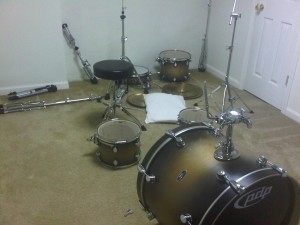If all we had to do to enjoy drumming was to play, life would be beauteous indeed. Alas, that is not the case.
An orchestra of activities is involved to then finally sit down and ‘do your thing’. However, not every one of those activities is necessarily fun.
Several months ago I moved to a temporary location, so I had to take my drums apart for the trip. My intention was to set them up and continue playing. However, the 500-year Atlanta flood put a stop to that. At this point there was no place to put the drums until I moved to yet another location that was more drum-friendly.
Well, that occurred last month. Now I’m at the new location, and I had all my drums, cymbals, and gear spread out all over the place. I figured that this might be a good time to start fresh.
So I took everything apart.
I realized that this might be a good time to re-tune the drums, even though this is not my favorite activity. I just want to play! But admittedly, if you want to sound good, or, if you want your drums to sound good to you, then learning to tune your drums is a necessity.
There are some good sources, both on YouTube and DVD, that explain most excellently how to tune the three main drum sections: bass, toms, and snare. I’ll cite them as I explain the process I went through.
Before that, though, one thing my set needed before anything else was a good cleaning. So to spare you the boring part of this drama, the only thing I used to clean the drums were dry paper towels – not even water. I rubbed everything with paper towels to buff them as shiny as possible. They came out quite nice, if I do say so myself!
The Bass Drum
As far as this drum goes, I’ve come around a bit as far as tuning and muffling goes, but mostly regarding muffling. In the DVD review “Unburying the Beater”, we learned about letting the drums, all of them, resonate to their full potential. Most of us try to tune the toms and snare so they resonate to their full potential, and/or ensure that we feel the rebound off these drums. But we don’t necessarily translate these concepts to the bass drum. We may tend to ‘bury the beater’, as it were, and thereby choking the resonance of the drum. The beater also wants to rebound off the bass drum head just like the sticks do off of the toms and snare, but we tend not to think of it that way.
Previously, when I tuned the bass drum, I put a pillow in it and placed it against the batter head, thereby getting the fast thud-like sound I wanted. But this time I wanted to give a shot to tuning without the pillow. In doing so, I would risk it sounding too boomy, but off I went.
My batter head is the Remo PowerStroke 3, which is a very popular bass drum head. One of its aspects is that it has an inner ply about two inches in from the edge that serves as a self-muffling agent. I figured that this should be enough for my little experiment. Based on the recommendations of Mike Michalkow’s “Drumming System”, the “Drum Tuning” section, I first tuned the resonant head by tightening the lug screws finger tight, then using the drum key to go about another complete turn or so (I should’ve written that little detail down – now I’m kicking myself!). I didn’t want to go too tight so as not to choke the natural resonance of the drum (this head also has the inner ply muffling as described above).

With the resonant head facing up, I then proceeded to tap about two inches in from each lug to ensure that all taps sounded exactly the same, or at least close enough. I’ve also decided to take Mike Michalkow’s recommendation of using the ‘open tuning’ method, meaning that I don’t press down on the center of the head when doing the tapping. Since it’s very possible that you will apply different pressure to the head as you go around to each lug, the tuning may not be accurate. I feel the open tuning method is a more accurate way of tuning. Anyways, I spent as much time as necessary, without rushing, to ensure every tap sounded as close to the same as possible.
And that was just the resonant head! I applied the same tuning principals to the batter head as well. I then attached my Off-Set double bass pedal to the drum, and whoa! The drum responded with more resonance than before, without the boominess! Actually, the resonance is similar to the sound a bass drum produces in a concert hall. It’s not a tone so much that’s produced, but rather a massive movement of air, echoing away. I love its sound now, and I attribute it to taking the time to ensure the drum was tuned properly.
The Toms
I then proceeded to the toms. I decided to take a slightly different approach for these as far as tuning them as optimally as possible. I was very impressed with John Good and Neil Peart’s discussion regarding Drum Workshop’s SSC technology (TheParadiddler.com subscribers have seen the YouTube videos).* John picked up an unfinished shell, and with a closed fist gently banged the drum. It produced a specific tone that could clearly be heard. He then proceeded to do the same thing with other shells that were exactly the same size, but whose tone got lower and lower depending on how the grain of each ply of wood was arrayed.
So I picked up the 10” tom, and with my fist I started banging on it.
Nothing.
Well, I heard the lug sockets rattling, but I couldn’t hear the tone of the drum. Maybe it was too small a drum, with too much hardware stuck on it for me to hear its tone. Same thing with the 12” tom. So I tuned them by first tightening them with my fingers as securely as I could, and then turning each lug (tension rod, whatever you like to call them) evenly until I got the tone that I expect from each tom.
Again, I spent all the time I needed to get every section of the head sounding the same so I could get the optimum sound from the drum. However, here is where there are several lines of thought. There are basically three ways to tune a tom:
- resonant head tuned higher than batter head
- batter head tuned higher than resonant head
- both heads tuned the same
The first method is very common, and when tuned this way the tone of the drum goes down as it resonates. The second method, less common, will tend to make the tone of the drum go up as it resonates.
However, I personally don’t like the tone to go up or down. My preference is the third method. I try as much as possible to tune the drum to one note, whatever it most easily resonates to. This is difficult to achieve, especially for the novice ‘tuner’, but worth the work. Which brings me back to the 14” tom.
I went back to lightly hitting the drum with my fist, and I heard a tone! The tone I was listening for. This I thought would be the tone that I would tune the drum to. So I went back and carefully tuned the drum to the sound that I thought I heard. Well now the drum sounds fantastic. It resonates beautifully, without going up or down. This and the bass drum might be my most accurately tuned drums in my kit.
The Snare
To me this is the biggest pain to tune (actually, for me they all are, but worth the work :)). I decided to go by the recommendation of Bob Gatzen in the YouTube video “Bob Gatzen – Snare Drum Tuning” (subscribers to TheParadiddler.com get the link). A must see, but basically he tunes the resonant head to the pitch of ‘A’, and the batter to the pitch of ‘C’. I just followed his recommendation for now, even though I’m not done tinkering with it. He also discusses how to install the actual snares, which is very helpful.
There is one problem I still have that I haven’t been able to figure out (or been too lazy to figure out!). My 10” tom does not cooperate well with either of my snares. I have a DW Pacific 5.5”x14” birch FS snare, and my ‘Number One’, my DW Pacific 5”x13” metal snare. With either one of these set up on the kit, whenever I hit the 10” tom the snares buzz like crazy. My temporary solution has been to use Moongel damper pads on the snare (even up to three at a time!) because I like the snare sound to pop, without much decay. So for my next tuning session, I’m going to fiddle with the tuning of the 10” tom again, and maybe putting the damper pad on it instead of the snare (or both). I’ll let you know how it goes!
All in all, tuning is all about personal preference, and somewhat of an acquired taste. I mentioned that I tried to stay away from muffling (the bass drum in particular) to try to get the most natural sound from the drum. This I have achieved (for now), and I’m happy with the sound, much more than I thought I would be. I was very skeptical that I could reduce the ‘boominess’ that seemed to be the unmuffled bass drum. But I’m liking it so far, and I thank Will Calhoun and Matt Ritter for the inspiration!
But I’m not against muffling at all. I most likely will employ some form of muffling here and there to achieve (or reduce) certain resonances. Also, once I obtain a couple of falam slam pads I’ll flip the bass drum beaters from the felt to the plastic side, and see how that sounds.
Because I spent so much time tuning my drums, to me they sound significantly better. I hope to convey that in my next cover, but my new location may have more to do with the sound than the tuning. You and I will be the judge!
If you have any suggestions and recommendations on tuning, please leave your comments here! Happy playing!+
_________
*Oh alright, here’s a link to part 1! 🙂
+Another excellent reference for drum tuning is Alfred Music Publishing‘s “The Drum Set Crash Course – Tuning Edition”, hosted by Russ Miller


 All rights reserved.
All rights reserved.
{ 1 comment… read it below or add one }
There is something about freshly polished and tuned drums! I have noticed a couple of lug washer rattles in two toms. I plan on using a stubby Phillips-Head on the inner shell screws as part of my re-tune regimen. I currently use Trick Drum Polish (soft cotton cloth) on the drums and hardware and Paiste Cymbal Cleaner on the cymbals (Paistes). That is a whole debate over whether to clean or not to clean the cymbals. I like ’em shiny .
Knowing when drum heads need replacing is something I need to learn.